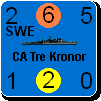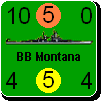Shannon V. OKeets
Posts: 22095
Joined: 5/19/2005
From: Honolulu, Hawaii
Status: offline

|
Here is a revised writeup for the Food in Flames optional rule plus two new ones for you to critique. (30 done, 51 to go).
=============================================================
[26][Food In Flames][RAW 29 s. 13.6.1]
This optional rule reflects the benefit Great Britain derived from the rest of the Commonwealth providing food for the British Isles. If supply lines to the far-flung member nations of the Commonwealth are maintained to Great Britain, then the Commonwealth’s total production is increased.
For each of (1) Australia, (2) India, and (3) South Africa where at least 1 resource is transported to a factory in Great Britain during a turn, the number of production points for the Commonwealth is increased by 1. Note that these are production (neither build nor resource) points and do not required processing by a factory. They are converted into build points the same as any other production points, by being multiplied by the production multiple.
=============================================================
[27][Factory Destruction & Construction][RAW 30 s. 22.2, 13.6.8]
This optional rule allows a player to build new factories and rebuild destroyed factories. Because factories cost a lot to build and take 4 turns to arrive, it is not always obvious if building a new one is a good thing to do. Repairing destroyed factories is cheaper and faster than building new ones. The only downside to repairing a factory, rather than building a new one, is that the repaired factory will be in the same hex in which it was destroyed at least once already.
For World in Flames building a factory is as close to a capital investment as a player can get. You give up near term build points (8 of them) with the expectation that you will get more than that back in the future. Since the factories won’t start producing until they arrive 4 turns hence, and you need for them to be operational for at least 8 turns to repay the original investment, we are talking about not seeing any return/profit on your investment until 2 years from when you build them. Even then, they are only worth something if you have unused resources sitting around continuously.
Each major power can build a maximum of 1 new factory a turn. They cost 8 build points each and take 4 turns to arrive. When a new factory does arrive, it is a blue factory and it must be placed in a city hex in the major power’s home country. For the Commonwealth the only home country in which a new factory can be placed is Britain (until Britain is conquered). There can never be more than 2 blue factories in a hex.
If a preexisting factory is destroyed, you don't have to rebuild it from scratch. Instead you can repair it. This is cheaper and faster (4 build points and 2 turns). Note that you can’t repair newly constructed factories, only ones that preexisted at the start of the war (prior to 1940). If you are playing with Engineer units, you can't repair a destroyed factory unless an engineer unit is stacked in the factory hex on the turn you pay for the repair.
All factories can be destroyed by Strategic bombardment. When there is a choice, the blue factories are destroyed before the red. A enemy player may also destroy a blue factory if one of his land units (this includes partisan units) is in supply in the factory’s hex during the victory check step. Each land unit can only destroy 1 factory a turn. Specifically, for a hex has 2 blue factories, you may only destroy both in the same turn if you have 2 land units there.
=============================================================
[28][Saving Oil Resources and Build Points][RAW 31 s. 13.5.1]
This optional rule lets a player save build points and oil resources (i.e., oil points). It should probably be used whenever the optional rule for oil is being used. With this rule in effect, a player does not have to depend on fresh oil every turn for reorganizing his troops. Instead, he can use the old stuff from previous turns. It also lets the player save resources and build points for production in later turns, essentially retaining excess production as inventory against a future date when it might be more useful.
A player can save oil resources and build points from turn to turn. To save an oil resource it must have neither been used in production nor for reorganizing units. The process is fairly easy, you transport an oil resource to a city or a port that you control and simply indicate that you are saving it. There is a limit on how much oil can be held in one hex: 4 for a city, 4 for a port, and double if it’s a major power’s capital. For example, London can store 16 oil points = (4 for the city + 4 for the port) * 2 for being a major power’s capital. You can't save non-oil resources. Neutral major powers can only save one oil per turn (in addition to their previously saved oil).
You save build points the same way as saving oil resources with the same constraints on number per hex. You can save both oil points and build points in the same hex (e.g., 16 of each in London).
Once you have saved oil resources you can use them exactly like any other oil resource: either to reorganize units or as resources for production. You can also transport saved build points and saved oil points like any other resource, with the additional flexibility that they may be transported to cities and ports that are not factories. Of course, an oil resource still has to get to a factory to be used for production.
In a later production step, you can remove saved build points from the map and add them to your build point total. You may spend any number saved at your capital but no more than 1 saved build point may be consumed per turn from each other city, useable factory and port. For example, you can spend 4 saved build points in Hamburg (1 for the city + 1 for the port + 2 for the factories), and an unlimited number in Berlin each turn).
If one of your land units enters a hex containing saved enemy oil resources (or saved enemy build points), they become your oil resources (or build points). Saved build points and saved oil resources can also be destroyed by strategic bombardment .
When you are using the optional rule for Synthetic Oil Plants, oil resources can only be saved at oil depots. Each oil depot can hold 4 oil points and the number of oil depots permitted in a hex is: 1 for a city, 1 for a port, and double if it’s a major power’s capital. This works out the same as before, with London having a maximum capacity of 16 saved oil points. The difference is that you must build the oil depot(s) at a cost of 1 build point each. When you build an oil depot, it has one oil point in it. There is no cost for placing additional oil points in an oil depot, up to their maximum value of 4 oil. Once you use the last oil point in an oil depot, the oil depot disappears and must be rebuilt if you want to store more oil there in the future.
Using the optional rule for Synthetic Oil Plants has the added change of permitting neutral major powers (like all other major powers) to save as many oil points per turn as they desire.
When you are using the optional rule for Factory Destruction and Construction, the strategic bombardment bonus for bombers that fly to their target uncontested (no enemy fighters) changes. Normally the bonus is a flat +1. When the optional rules for Factory Destruction and Construction and Saving Oil Resources are both in effect, the addition is 0.1 times the number of factories, oil resources, synthetic oil plants (if that optional rule is being used), saved oil, and saved build points in the hex. Any fraction is converted to the next whole number. For example, 3 factories + 3 saved oil + 5 saved build points gives a +2 bonus to the strategic bombers (1.1 –> 2). Also, there is now no stacking limit for saved build points or saved oil resources in any city or port.
_____________________________
Steve
Perfection is an elusive goal.
|
 Printable Version
Printable Version








 New Messages
New Messages No New Messages
No New Messages Hot Topic w/ New Messages
Hot Topic w/ New Messages Hot Topic w/o New Messages
Hot Topic w/o New Messages Locked w/ New Messages
Locked w/ New Messages Locked w/o New Messages
Locked w/o New Messages Post New Thread
Post New Thread